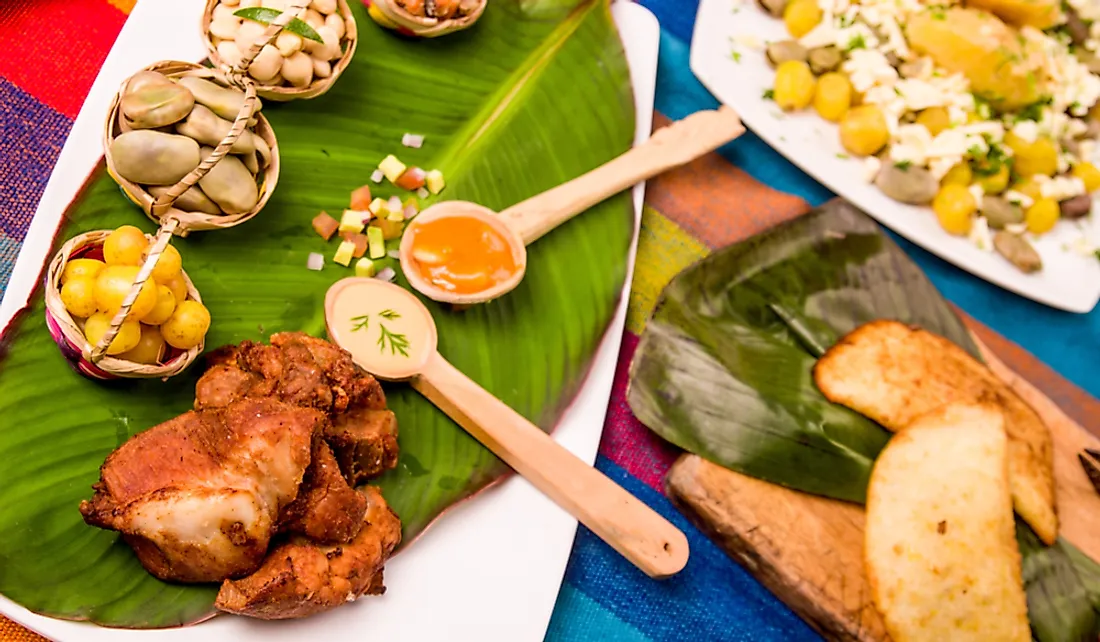The Culture Of Ecuador

The northwestern South American country of Ecuador has a rich culture that is a blend of both Amerindian and European (Andalusian and Castilian Spaniard) cultures.
6. Ethnicity, Language, and Religion in Ecuador
Ecuador is home to a population of 16,498,502 individuals. Mestizos account for 71.9% of Ecuador’s population. Montubio, Amerindian, white, Afroecuadorian, mulatto, and black are the other ethnic groups with significant representation in Ecuador’s population. Spanish is the official language of Ecuador and is spoken by 93% of the population. Indigenous languages like Quechua are spoken by some of the country’s indigenous ethnic groups. 74% of Ecuador’s population are Roman Catholic Christians. Evangelical Christians represent 10.4% of Ecuador’s population.
5. Ecuadorian Cuisine
Ecuador has a diverse cuisine that varies with altitude due to the varying agricultural conditions. In the coastal area of the nation, rice, lentils, pasta, and plantain are the staples. These are consumed with chicken, beef, and seafood. In the mountainous area, rice, corn, and potatoes are the staples and are consumed with pork, beef, chicken, or guinea pig meat. Cassava is a staple of the diet in the rainforest region. Hornado, a street food comprising of roasted pork and potatoes, is very popular in Ecuador’s highland areas. Some other popular dishes of the Ecuadorian cuisine are llapingachos (potato balls), seco de chivo (a goat meat stew), patacones (fried and mashed unripe plantains), etc. Tree tomato, banana, passionfruit, granadilla, naranjilla, etc., are some of the fruits consumed in Ecuador.
Aguardiente prepared from fermented sugar-cane is the most widely consumed alcoholic beverage in Ecuador. Yogurt drinks in various fruit flavors are also popular. Pinol (a drink made from toasted barley flour, spices, and unrefined sugar) and colada morada (a drink made from black corn flour, unrefined sugar, fruits, and spices) are some other non-alcoholic beverages consumed in Ecuador.
4. Literature and the Arts in Ecuador
Ecuador’s written literary history began with Spanish colonial rule in the country that led to the establishment of formal educational institutions. However, prior to that, the indigenous Ecuadorian people had a rich legacy of oral literature. With the spread of formal education, many Ecuadorians started writing in the Spanish language and produced works of great quality. However, since a large portion of Ecuadorian literature remains untranslated, it has not gained as much global popularity as it deserves. Graffiti is an important form of expression of political and social thoughts in Ecuador. Journalists from the country have often quoted graffiti writings in their work. Juan Montalvo, Juan León Mera, Alfredo Pareja, Jorge Icaza are some of the many renowned writers of Ecuador.
Ecuador has a rich tradition of folk art. The indigenous communities of the country specialize in various art and craft forms like painting, wood carving, leatherwork, woolen tapestries, carpet-making, agave-fiber bag making, etc. Tigua’s Kichwa people are renowned for their traditional paintings on sheepskin canvases. Tigua people produce highly decorative drums and masks.
3. Performance Arts in Ecuador
Ecuador has a spirited music and dance scene as the people of the country indulge in celebrations and festivals all year round. The country’s performing arts scene is influenced by both its indigenous music and dance forms as well as those introduced from outside. Pasillo, Pasacalle, and Yarab are the most popular genre of indigenous folk songs. Caribbean salsa and Colombian cumbia are modern music genres popular in Ecuador. Sanjuanito is a musical style that is prevalent in the Andean region of Ecuador. Marimba and bomba are popular Afro-Ecuadorian music styles in the country.
2. Sports in Ecuador
Football (soccer) is Ecuador’s most popular sport. It is played both professionally and informally throughout the nation. The football matches played by the country’s national team are the most viewed spectator sports events in Ecuador. Other popular sports played in Ecuador include tennis, volleyball, basketball, and baseball. The Ecuadorian athletes have participated in eleven Summer Olympic Games. In 2018, the country’s sent athletes to the Winter Olympic Games for the first time. Basketball is considered to be the second sport behind football, Ecuavóley is a form of volleyball played in Ecuador. It includes three-person teams and has more relaxed rules than the traditional game. Winter sports are popular in the Andes mountains. Whitewater kayaking, mountain biking, motorbiking, inline hockey, skiing, snowboarding, etc., are becoming increasingly popular in Ecuador.
1. Life in the Ecuadorian Society
The way of life of the Ecuadorians varies greatly with race, ethnicity, and region. While a male-dominated society prevails in some parts of the country, gender equality is the norm in other parts. The law allows both men and women to receive education and hold jobs. The female participation rate in the Ecuadorian workforce is quite high. Women are generally employed in academics, finance, banking, NGOs, etc.
Marriages in Ecuador are generally based on romantic relationships. Marriage customs and traditions vary widely. Household size ranges from nuclear to extended. The mother plays a prominent role in nurturing the children and managing the household while the father is regarded as the provider. Children are highly valued in Ecuadorian society.
Respeto (respect) is the most important etiquette across all levels of the Ecuadorian society. Respect for each other determines interpersonal relationships in the country. Disrespect leads to conflicts among individuals or groups.











